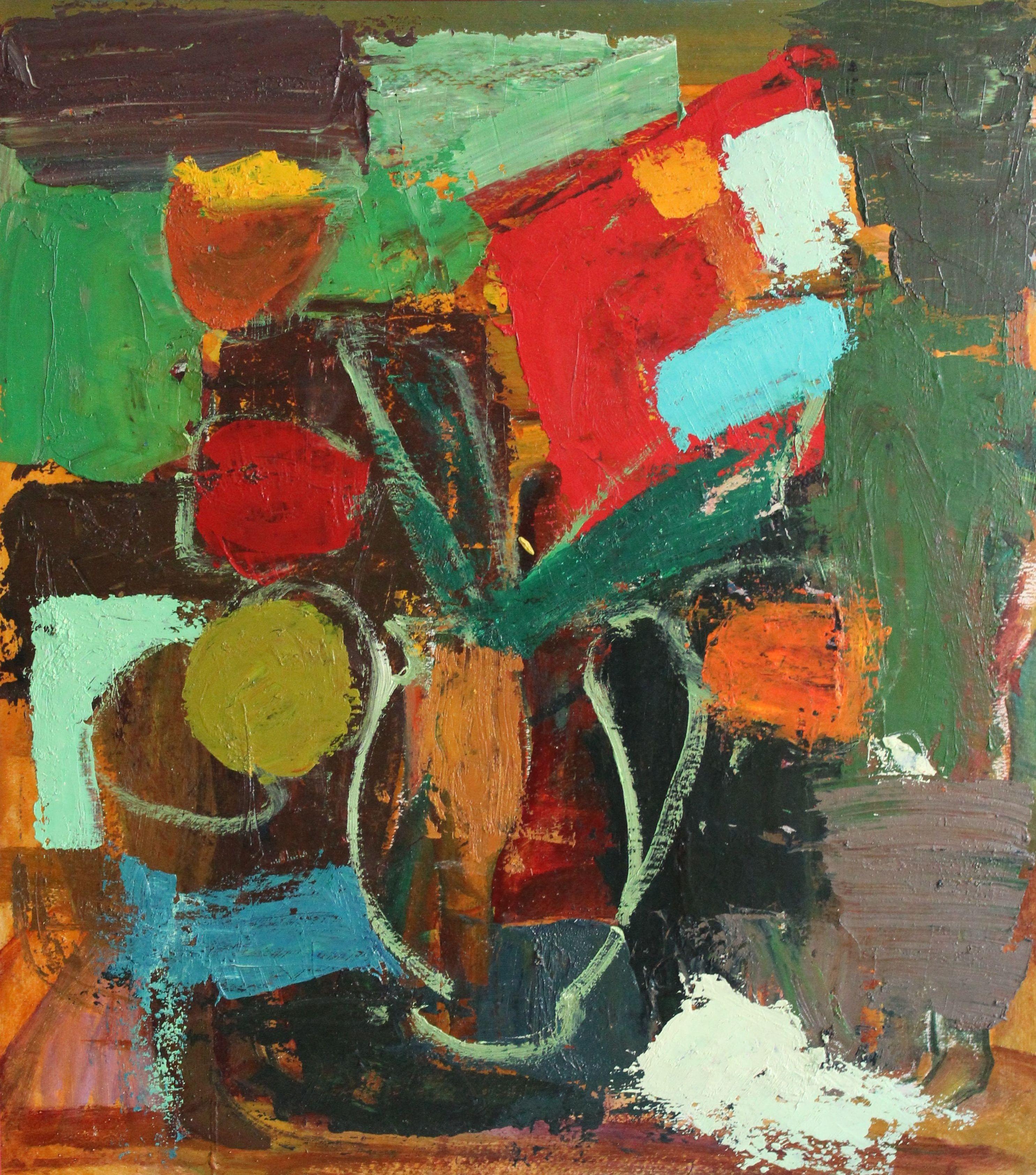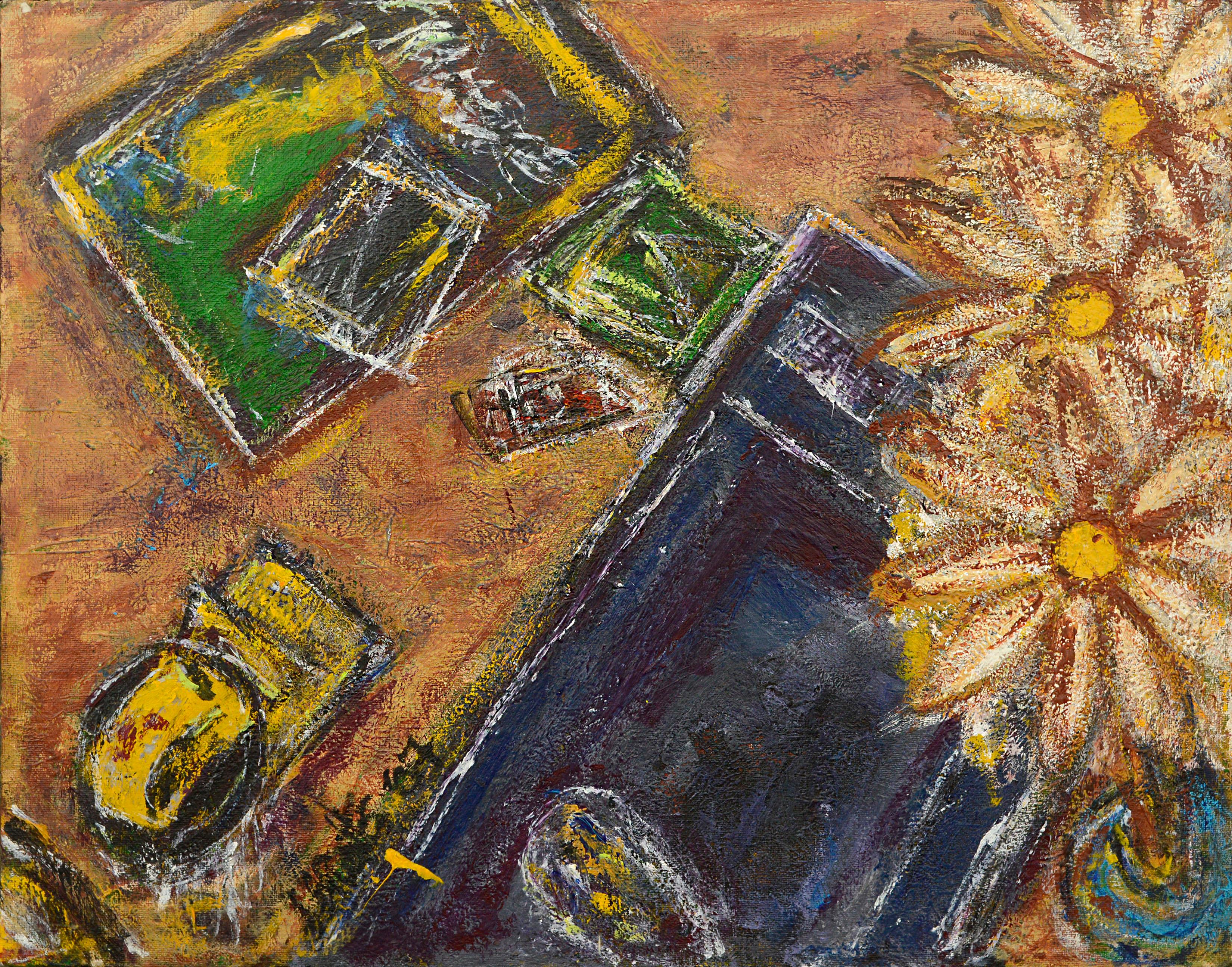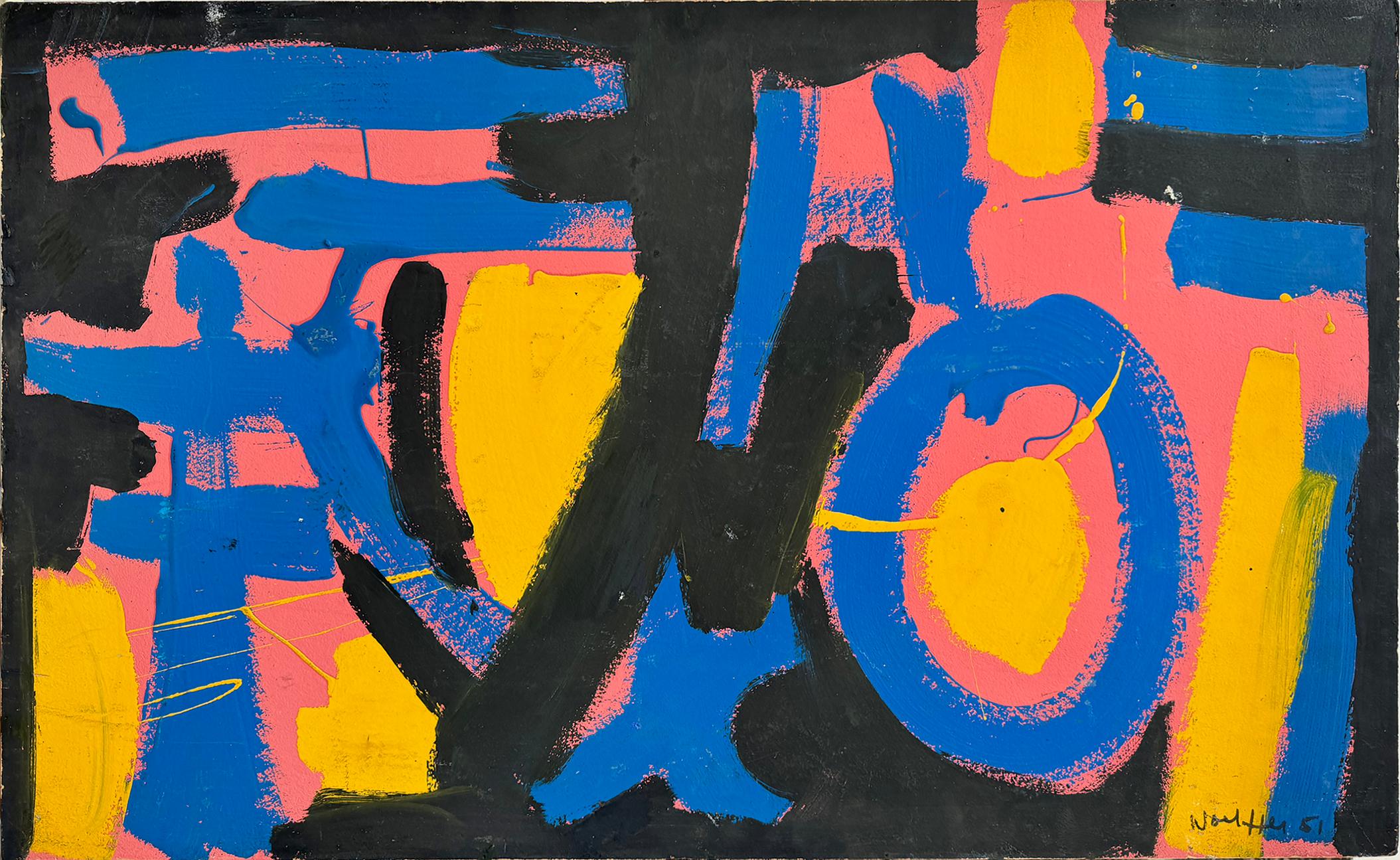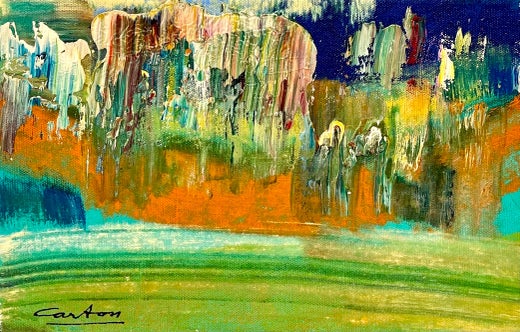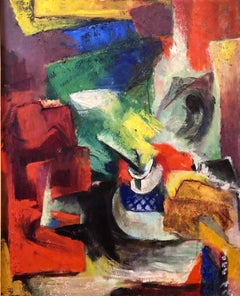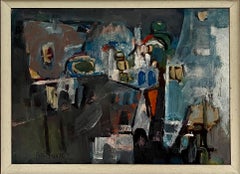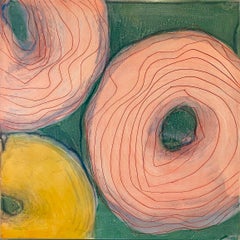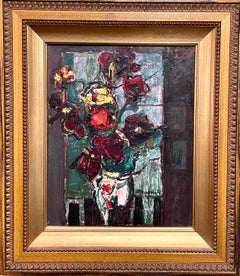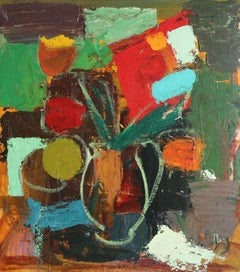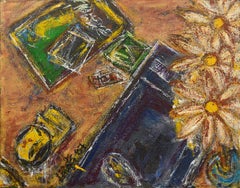Items Similar to American Abstract Expressionist Flowers Oil Painting Norman Carton WPA Artist
Want more images or videos?
Request additional images or videos from the seller
1 of 18
Norman CartonAmerican Abstract Expressionist Flowers Oil Painting Norman Carton WPA Artistc.1940-1950's
c.1940-1950's
About the Item
Norman Carton (1908 – 1980) was an American artist and educator known for abstract expressionist art. He was born in the Ukraine region of Imperial Russia and moved to the United States in 1922 where he spent most of his adult life.
A classically trained portrait and landscape artist, Carton also worked as a drafter, newspaper illustrator, muralist, theater set designer, photographer, and fabric designer and spent most of his mature life as an art educator. Carton showed in and continues to be shown in many solo and group exhibitions. His work is included in numerous museums and private collections throughout the world.
Norman Carton was born in the Dnieper Ukraine territory of the Russian Empire in 1908. Escaping the turbulence of civil war massacres, he settled in Philadelphia in 1922 after years of constant flight. While attending the Pennsylvania Museum School of Industrial Art, Carton worked as a newspaper artist for the Philadelphia Record from 1928 to 1930 in the company of other illustrator/artists who had founded the Ashcan School, the beginnings of modern American art. From 1930 to 1935, he studied at the Pennsylvania Academy of Fine Arts under Henry McCarter, who was a pupil of Toulouse-Lautrec, Puvis de Chavanne, and Thomas Eakins. Arthur Carles, especially with his sense of color, and the architect John Harbison also provided tutelage and inspiration. Following his time at the Pennsylvania Academy of Fine Arts, Carton studied at the Barnes Foundation from 1935 to 1936 where he was influenced by an intellectual climate led by visiting lecturers John Dewey and Bertrand Russell as well as daily access to Albert C. Barnes and his art collection.
Carton was awarded the Cresson Traveling Scholarship in 1934 which allowed him to travel through Europe and study in Paris. There he expanded his artistic horizons with influences stemming from Henri Matisse, Pablo Picasso, Chaim Soutine, and Wassily Kandinsky. While at the Pennsylvania Academy of Fine Arts, Carton was also awarded the Toppan Prize for figure painting as well as the Thouron Composition Prize. He received numerous commissions as a portrait artist, social realist, sculptor, and theatrical stage designer as well as academic scholarships. During this time, Carton worked as a scenery designer at Sparks Scenic Studios, a drafter at the Philadelphia Enameling Works, and a fine art lithographer.
From 1939 to 1942, the Works Progress Administration (WPA) Federal Art Project employed Carton as a muralist and easel artist. He collaborated with architect George Howe. The WPA commissioned Carton to paint major murals at the Helen Fleischer Vocational School for Girls in Philadelphia, the Officers’ Club at Camp Meade Army Base in Maryland, and in the city of Hidalgo, Mexico. Throughout the 1940s, Carton exhibited and won prizes for his semi-abstract Expressionist and Surrealist paintings. He socialized with and was inspired by Émile Gauguin and Fernand Leger. During World War II, Carton was a naval structural designer and draftsman at the Cramps Shipbuilding Corporation in Camden, New Jersey. Here, he created non-objective sculpture with metal. After the war, Carton co-founded a fabric design plant in Philadelphia. He produced hand-printed fabrics for interiors and fashion that were featured in Harper’s Bazaar, Vogue and Women’s Wear Daily. Original fabric designs were commissioned by notable clients including Lord & Taylor, Gimbels, and Nina Ricci. Some of these designs are at the Metropolitan Museum of Art. Carton traded his partnership in the fabric design company in 1949 to focus full-time on painting. Carton had his first solo exhibition in 1949 at the Philadelphia Art Alliance. This show was followed closely by solo exhibitions at the Laurel Gallery (New York City) and Dubin Gallery (Philadelphia). At this time, his exhibited work was Abstract Impressionist. In addition to painting, he taught classes at the Philadelphia Museum of Art and was the Founder and first President of the Philadelphia chapter of Artist’s Equity Association. The Philadelphia Museum of Art and the organization of the National Museums of France commissioned Carton to travel to Europe, mainly France, in 1950 for a color photography study of continental masterpieces. He was granted access to study the restoration of the Mona Lisa and was one of the very few to be given permission to remove the painting from its frame. During his three year stay in Paris, he had solo exhibits at La Sorbonne and Gallery Rene Breteau and was in 15 group shows in Paris salons including Les Sur Independants, Salon d’Automne, and Realities Nouvelles. He also exhibited at the Musee d’Art Juif where he won the Prix d’Art. The Cercle Paul Valery twice sponsored Carton to present lectures at the Sorbonne. He conducted seminars at the Louvre for the Cercle Esthetique Internationale and taught classes in and directed stage and costume design for the Theatre de Recherche at the Paris Opera. Among his Paris artist colleagues were Chana Orloff, Earl Kerkam, Sam Francis, Claire Falkenstein, Lawrence Calcagno, Norman Bluhm, and Al Held.
When Carton returned to the United States in 1953, he settled in New York City where he worked in the company of the leading artists of the day with whom he appeared in a number of group shows including the Whitney Museum of American Art's 1955-1956 “Exhibit of Contemporary American Painting.” This exhibition included such notable artists as Richard Diebenkorn, Joan Mitchell, James Brooks, Grace Hartigan, Franz Kline, Georgia O'Keeffe, Adolph Gottlieb, Robert De Niro Sr., and many others. The Whitney subsequently purchased a Carton.
The mid-1950s to the 1970s was a busy time for Carton during which he received a great deal of recognition. He had solo exhibitions one gallery after another: Martha Jackson, Staempfli, Granite and World House, New York City; Tirca Karlis, Provincetown; Gres, Washington D.C.; Dumbarton, Boston; and Joachim, Chicago.
Carton's large canvases traveled in major collections to such venues as the Smithsonian American Art Museum (was SNCFA) and the RISD Museum of Fine Arts with significant works of artists such as Jim Dine, Hans Hofmann, Robert Motherwell, Louise Nevelson, and Jackson Pollock. Other group exhibitions included Whitney, Corcoran, Phillips, Dallas, Dayton, Walker, and Chrysler Museums among others.
Among his NYC artist colleagues were also now Louise Nevelson and John Hultberg who he had helped welcome at the Martha Jackson Gallery. In 1962, with the aid of two other artists, he formed the Dewey Gallery, one of the first New York City galleries owned and operated by artists. He presented his work during the opening exhibition.
During his lifetime, Carton was in at least 150 group exhibits and more than 20 solo shows and continued to receive many PAFA fellowship awards. He was popularly and critically regarded as possessing a painterly style of superlative action and a unique knowledge as a colorist, Carton ground his own pigments and painted with a brilliant palette. More recently, he exhibited with Willem de Kooning and Mark Rothko among other great Abstract Expressionists as well as Picasso and Matisse.
Norman Carton was also an art educator throughout much of his life. Beginning in 1960, Carton worked on the art faculty at the New School where he would remain until his death. From 1948 to 1949, he taught painting and composition at the Philadelphia Museum of Art. From 1950 to 1953, he conducted seminars at the Louvre and the Sorbonne while living in Paris. Also while in Paris, Carton taught classes in and directed stage and costume design for the Theatre de Recherche at the Paris Opera. He also gave lectures at the Pratt Institute and the Chrysler Museum of Art as well as the Whitney Museum of American Art. Carton moderated panel discussions between prominent artists and educators and appeared in radio interviews. In 1960 and 1961, he painted at the MacDowell Colony in New Hampshire as a fellow. Carton also taught for a time at Long Island University.
Norman Carton has had more than 25 solo exhibitions and was part of over 175 group exhibitions. His work is currently in more than 20 museums and hundreds of private collections throughout the world.
Carton's works continue to be included in present day exhibitions including at Hollis Taggart Gallery entitled Wild and Brilliant: The Martha Jackson Gallery and Post-War Art, Quogue Gallery entitled 1950s and 1960s Works on Paper, the Nassau County Museum of Art entitled Blue in 2020 as well as Energy: The Power of Art in 2019 and at the Anita Shapolsky Gallery in 2019 entitled Inspiration & Exploration.
A representational portion of Carton's papers which include correspondence, writings, notes, exhibition catalogs and sketchbooks were donated to the Smithsonian Archives of American Art where they remain.
Selected museum collections
Albright–Knox Art Gallery, Buffalo, New York
Blanton Museum of Art, University of Texas at Austin
Chrysler Museum of Art, Norfolk VA
Fonds National d'Art Contemporain / Center National d'Arts Plastiques, Paris
Moscow Conservatory, Moscow, Russia
Musée d'art moderne (Saint-Étienne, France), 1954-1992
Musée d'Art et d'Histoire du Judaïsme, Paris, France
Museo Nacional de Bellas Artes de La Habana, Havana, Cuba
Museum of Fine Arts, Budapest, Hungary
National Gallery of Art, Washington, D.C.
Neuberger Museum of Art, Purchase, New York
Palmer Museum of Art, State College, Pennsylvania
Pennsylvania Academy of the Fine Arts, Philadelphia, Pennsylvania
Rhode Island School of Design Museum, Providence, Rhode Island
The New School Art Collection, New York, New York
Whitney Museum of American Art, New York, New York
Yale University Art Gallery, New Haven, Connecticut
- Creator:Norman Carton (1908 - 1980, American)
- Creation Year:c.1940-1950's
- Dimensions:Height: 14 in (35.56 cm)Width: 10.5 in (26.67 cm)
- Medium:
- Movement & Style:
- Period:
- Condition:wear to edges and corners where it was framed. it is currently unframed.
- Gallery Location:Surfside, FL
- Reference Number:1stDibs: LU38211758042
Norman Carton
Norman Carton was an American artist and educator known for Abstract Expressionist works in oil on canvas. While this was his most recognized style and medium, Carton was primarily a colorist and also worked as a muralist, classically trained portrait and landscape artist, sculptor, theater set and fabric designer, and illustrator as well as in a variety of abstractions. He has a large museum collection and commercial history, showing in more than 20 solo and 135 group exhibitions." He was awarded numerous awards, prizes and fellowships for painting. In the 1930s he was part of the WPA creating murals. In the 1940s, he founded a fabric design and production firm which was featured in Interiors magazine, Vogue, Harper's Bazaar, and Women's Wear Daily. These were hand-printed fabrics and his clients were Nina Ricci, Hattie Carnegie, Lord & Taylor, and others. In 1962 Norman Carton opened his own Dewey Gallery in NYC. Carton's works continue to be included in present day exhibitions including at Quogue Gallery entitled 1950s and 1960s Works on Paper,, at the Nassau County Museum of Art entitled Blue in 2020 as well as Energy: The Power of Art in 2019, and at the Anita Shapolsky Gallery in 2019 entitled Inspiration & Exploration. Norman Carton's 2020 solo exhibition at Quogue Gallery was reviewed by Charles A Riley. A representational portion of Carton's papers which include correspondence, writings, notes, exhibition catalogs and sketchbooks were donated to the Smithsonian Archives of American Art where they remain.
About the Seller
4.9
Platinum Seller
Premium sellers with a 4.7+ rating and 24-hour response times
Established in 1995
1stDibs seller since 2014
1,760 sales on 1stDibs
Typical response time: 1 hour
- ShippingRetrieving quote...Shipping from: Surfside, FL
- Return Policy
Authenticity Guarantee
In the unlikely event there’s an issue with an item’s authenticity, contact us within 1 year for a full refund. DetailsMoney-Back Guarantee
If your item is not as described, is damaged in transit, or does not arrive, contact us within 7 days for a full refund. Details24-Hour Cancellation
You have a 24-hour grace period in which to reconsider your purchase, with no questions asked.Vetted Professional Sellers
Our world-class sellers must adhere to strict standards for service and quality, maintaining the integrity of our listings.Price-Match Guarantee
If you find that a seller listed the same item for a lower price elsewhere, we’ll match it.Trusted Global Delivery
Our best-in-class carrier network provides specialized shipping options worldwide, including custom delivery.More From This Seller
View AllBeulah Stevenson 1950s Abstract Expressionism American Woman Artist Oil Painting
By Beulah Stevenson
Located in Surfside, FL
Dimensions: 32"h, 25"w canvas; 38.5"h, 32"with frame
Work is titled "Two Lillies"
Elsie Stevenson (1890–1965) was an American painter and printmaker.
Beulah Stevenson, (1875-1965...
Category
Mid-20th Century Abstract Expressionist Abstract Paintings
Materials
Canvas, Oil
Polish Israeli Abstract Vibrant Cityscape Tel Aviv Modernist Painting Mairovich
By Zvi Mairovich
Located in Surfside, FL
Bold, colorful abstract cityscape of Tel Aviv
15 X 19 inches including mat (needs new mat).
painting is 10.5 X 14.5
Provenance: prominent South Florida art...
Category
20th Century Abstract Abstract Paintings
Materials
Oil, Gouache, Board
"AKEE" Oil Painting, Marylyn Dintenfass Modernist Abstract Expressionist Pop Art
By Marylyn Dintenfass
Located in Surfside, FL
Provenance: Babcock Galleries (bears their label verso.) signed verso with artists monogram signature.
Marylyn Dintenfass (born 1943) is an American painter, printmaker, and sculptor. She is primarily known for her oil paintings, which use a dynamic color palette and lexicon of gestural imagery to explore dualities in the human experience and everyday sensual pleasures.
Marylyn Dintenfass was born in 1943 in Brooklyn, New York and spent most of her early years in Brooklyn and then Long Island. She attended Queens College, and graduated in 1965 with a bachelor's degree in Fine Arts. During this time, the artist worked with Abstract Expressionist painter John Ferren and muralist Barse Miller. Marilyn Dintenfass explored new media and developed her own reaction to abstract expressionism with color, line, and gesture. Dintenfass acquired an appreciation for a broad range of materials that led to major sculpture installations composed of ceramic materials, steel, lead, wood, wax and a variety of pigments and epoxies.
Following a tour of museums in Amsterdam, Paris and Rome, the artist made her way to Jerusalem in 1966. During this journey, the artist worked with painter Ruth Bamberger, studied etching and mingled with the artists and intellectuals of the city. The result was Dintenfass's first architectural commission, to design the “Pop Op Disco,” Jerusalem's first disco. This commission allowed her to work with an array of materials to employ shapes, surfaces, textures, colors, and lights, all of which coalesced in her consciousness that would become important components of her mature personal visual vocabulary. Dintenfass also married and started her family during these years.
Art critic Meredith Mendelsohn writes, “Dintenfass uses luscious colors, repetitive forms, and a gestural intensity that combines Abstract Expressionism and Pop Art.”
Dintenfass often works with oil paint on wooden panels fragmented into parts of a grid. "After completing a painting," writes curator and critic Lilly Wei in a study of Dintenfass' work, "Dintenfass literally takes it apart, treating each panel as a discrete entity, exchanging panels between works in an aesthetic mix and match as she searches for interactions and relationships of color and form that satisfy her sense of visual excitement, sparked by the frisson of the dissonant." In an interview with critic Irving Sandler, Dintenfass speaks of the grid as a necessary, formal restraint for the passion of the gestural marks it contains. Joyce Robinson illuminates; “Dintenfass is at heart, though, a painter, and the grid, with its reference to and notion of modular parts, has remained central to her artistic enterprise, functioning as a kind of Apollonian matrix holding in check the exuberant, vividly colored abstractions of this essentially Dionysian artist.”
Lilly Wei adds, "Ultimately, however, Dintenfass is more sensualist than theorist, and her paintings owe much of their allure to their materiality and the dazzle of color. Her array of ripe, radiant, saturated hues—a palette of gorgeous diversity—can be silkily smooth and nuanced; boldly exuberant; or edgily, feverishly discordant."
The artist's abstract imagery usually appears in her work as various forms of stripes or circles arranged across translucent layers of alternating matte and high gloss textures. In a conversation with gallery owner, John Driscoll, Dintenfass likens these symbols to language that predates the written word, saying her "work relates to communication through the visceral channel." Rooted in autobiography, the artist's paintings also examine the contrast between what she calls the “micro” and the “macro.” At times the shapes simultaneously resemble cells under a microscope and visions of the cosmos. Dintenfass' themes explore the dualities of everyday pleasures; depending on the focus of a series, her symbols might conjure characters, candies, car wheels, or paint itself.
Although known for her paintings, Dintenfass was first recognized for her sculptural installations. Her innovative use of mixed media (ceramics, epoxies, wax, pigments, steel, lead, wood, etc.) transformed understanding of what a “ceramic” work of art could be and firmly fixed her position and influence among a generation of mixed media artists expanding the traditional definitions and boundaries of object and materials to create modern art. The results came as architectural reliefs and installation sculpture unique to her organic but structural personal style. Similar to her paintings, Dintenfass developed a modular language of symbols, amalgams of line and curve, which she would combine to create detailed pictographic languages all her own, what she has called “organic alphabets.” As Ted Castle relates, “Ideas are furtive elements, stolen from the matrix, so as to be reformed by human genius into something unforeseen—a poem, a painting, a game of dominoes, a television set, a brick, a tile, a cup. Marylyn Dintenfass is a master of the transformation of ideas into palpable form.”
Dintenfass has also been commissioned to create many large-scale installations, including works for the State of Connecticut Superior Courthouse; the Port Authority of NY 42nd Street Bus Terminal; IBM in Atlanta, Charlotte, and San Jose; The Baltimore Federal...
Category
Early 2000s Abstract Abstract Paintings
Materials
Oil, Panel
Polish Israeli Abstract Flowers Tel Aviv Modernist Vibrant Floral Oil Painting
By Zvi Mairovich
Located in Surfside, FL
Bold, colorful abstract bouquet of flowers in a vase.
25.5 X 20 inches, framed. 16 X 12.5 canvas in original carved wood frame.
Provenance: Gallery Hadassa (Klachkin) Tel Aviv. Bears label remnant verso.
Zvi Mairovich (1911-1974) was one of the most important Israeli abstract painters. Born in Krosno Poland, he moved to Berlin in 1929, studying painting with Karl Hofer...
Category
20th Century Abstract Abstract Paintings
Materials
Canvas, Oil
Abstract Still Life Oil Painting with Ink Theresa Bernstein Flowers in Vase
By Theresa Bernstein
Located in Surfside, FL
Theresa Bernstein, 1890 - 2002
Abstract Still Life Oil and Pen on Paper Painting (1994) by Theresa Bernstein
Frame: 26" X 22", Image: 18.5" X 14.75"
A Polish born American modernist figurative artist in the traditions of the Ashcan and New York Realism Schools, wife of William Meyerowitz. The artwork represents a still life with two flower vases. Signed by the artist and dated 1994 in the lower left.
Theresa Ferber Bernstein-Meyerowitz (1890 – 2002) was an American artist, writer, and supercentenarian born in Kraków, in what is now Poland, and raised in Philadelphia. She received her art training in Philadelphia and New York City. Over the course of nearly a century, she produced hundreds of paintings and other artwork, plus several books and journals.
Bernstein and her husband William Meyerowitz (a WPA, New deal artist), who was also an artist, lived and worked in Manhattan and Gloucester, Massachusetts. She painted portraits and scenes of daily life, plus reflections of the major issues of her time, in a modern style that evolved from realism to expressionism. She was active in several art associations and promoted her husband's work as well as her own. Her artworks are found in dozens of museums and private collections in the United States and abroad. She remained active all her life and was honored with a solo exhibition of 110 art works to celebrate her 110th birthday.
Bernstein also authored several books, including a biography of her husband and a journal about their many trips to Israel.
She died in 2002, just a couple of weeks short of her 112th birthday.
Theresa Ferber Bernstein was born in Cracow, Poland, on March 1, 1890. She was the only child of Isidore Bernstein, a Jewish textile...
Category
1990s Abstract Abstract Paintings
Materials
Paper, Oil, Pen
Abstract Red Persimmon Oil Painting on Panel Marylyn Dintenfass Modernist
By Marylyn Dintenfass
Located in Surfside, FL
Provenance: Babcock Galleries (bears their label verso. signed verso with artists monogram signature.
Marylyn Dintenfass (born 1943) is an American painter, printmaker, and sculptor. She is primarily known for her oil paintings, which use a dynamic color palette and lexicon of gestural imagery to explore dualities in the human experience and everyday sensual pleasures.
Marylyn Dintenfass was born in 1943 in Brooklyn, New York and spent most of her early years in Brooklyn and then Long Island. She attended Queens College, and graduated in 1965 with a bachelor's degree in Fine Arts. During this time, the artist worked with Abstract Expressionist painter John Ferren and muralist Barse Miller. Marilyn Dintenfass explored new media and developed her own reaction to abstract expressionism with color, line, and gesture. Dintenfass acquired an appreciation for a broad range of materials that led to major sculpture installations composed of ceramic materials, steel, lead, wood, wax and a variety of pigments and epoxies.
Following a tour of museums in Amsterdam, Paris and Rome, the artist made her way to Jerusalem in 1966. During this journey, the artist worked with painter Ruth Bamberger, studied etching and mingled with the artists and intellectuals of the city. The result was Dintenfass's first architectural commission, to design the “Pop Op Disco,” Jerusalem's first disco. This commission allowed her to work with an array of materials to employ shapes, surfaces, textures, colors, and lights, all of which coalesced in her consciousness that would become important components of her mature personal visual vocabulary. Dintenfass also married and started her family during these years.
Art critic Meredith Mendelsohn writes, “Dintenfass uses luscious colors, repetitive forms, and a gestural intensity that combines Abstract Expressionism and Pop Art.”
Dintenfass often works with oil paint on wooden panels fragmented into parts of a grid. "After completing a painting," writes curator and critic Lilly Wei in a study of Dintenfass' work, "Dintenfass literally takes it apart, treating each panel as a discrete entity, exchanging panels between works in an aesthetic mix and match as she searches for interactions and relationships of color and form that satisfy her sense of visual excitement, sparked by the frisson of the dissonant." In an interview with critic Irving Sandler, Dintenfass speaks of the grid as a necessary, formal restraint for the passion of the gestural marks it contains. Joyce Robinson illuminates; “Dintenfass is at heart, though, a painter, and the grid, with its reference to and notion of modular parts, has remained central to her artistic enterprise, functioning as a kind of Apollonian matrix holding in check the exuberant, vividly colored abstractions of this essentially Dionysian artist.”
Lilly Wei adds, "Ultimately, however, Dintenfass is more sensualist than theorist, and her paintings owe much of their allure to their materiality and the dazzle of color. Her array of ripe, radiant, saturated hues—a palette of gorgeous diversity—can be silkily smooth and nuanced; boldly exuberant; or edgily, feverishly discordant."
The artist's abstract imagery usually appears in her work as various forms of stripes or circles arranged across translucent layers of alternating matte and high gloss textures. In a conversation with gallery owner, John Driscoll, Dintenfass likens these symbols to language that predates the written word, saying her "work relates to communication through the visceral channel." Rooted in autobiography, the artist's paintings also examine the contrast between what she calls the “micro” and the “macro.” At times the shapes simultaneously resemble cells under a microscope and visions of the cosmos. Dintenfass' themes explore the dualities of everyday pleasures; depending on the focus of a series, her symbols might conjure characters, candies, car wheels, or paint itself.
Although known for her paintings, Dintenfass was first recognized for her sculptural installations. Her innovative use of mixed media (ceramics, epoxies, wax, pigments, steel, lead, wood, etc.) transformed understanding of what a “ceramic” work of art could be and firmly fixed her position and influence among a generation of mixed media artists expanding the traditional definitions and boundaries of object and materials to create modern art. The results came as architectural reliefs and installation sculpture unique to her organic but structural personal style. Similar to her paintings, Dintenfass developed a modular language of symbols, amalgams of line and curve, which she would combine to create detailed pictographic languages all her own, what she has called “organic alphabets.” As Ted Castle relates, “Ideas are furtive elements, stolen from the matrix, so as to be reformed by human genius into something unforeseen—a poem, a painting, a game of dominoes, a television set, a brick, a tile, a cup. Marylyn Dintenfass is a master of the transformation of ideas into palpable form.”
Dintenfass has also been commissioned to create many large-scale installations, including works for the State of Connecticut Superior Courthouse; the Port Authority of NY 42nd Street Bus Terminal; IBM in Atlanta, Charlotte, and San Jose; The Baltimore Federal...
Category
Early 2000s Abstract Abstract Paintings
Materials
Oil, Panel
You May Also Like
Still life with sunflowers. Oil on cardboard, 38x38 cm
Located in Riga, LV
Aleksandr Rodin (1922-2001)
Painter Born in a family of farmers. Wife Rasma Lace - art scholar. Studied at the Stalingrad School of Art, Saratov Art School, graduated from the Depar...
Category
1980s Abstract Expressionist Still-life Paintings
Materials
Oil, Cardboard
Folksong. 2001, oil on cardboard, 92, 5 x 57, 5 cm
Located in Riga, LV
Folksong
2001, oil on cardboard, 92,5x57,5 cm
Jekabs Arturs Springis
(1907– 2004) Painter, Latvia
1924 – 1927 – he learned at Aizpute Secondary School
1927 – 1930 – learning at ...
Category
Early 2000s Abstract Expressionist Abstract Paintings
Materials
Oil, Cardboard
Flowers of life. Bilateral. Oil on cardboard, 73x65 cm
Located in Riga, LV
Flowers of life. Bilateral. Oil on cardboard, 73x65 cm
Aleksandr Rodin (1922-2001)
Painter Born in a family of farmers. Wife Rasma Lace - art scholar. Studied at the Stalingrad Sch...
Category
1980s Abstract Expressionist Still-life Paintings
Materials
Oil, Cardboard
Three Daisies Abstracted Still-Life
By Daniel David Fuentes
Located in Soquel, CA
Whimsical abstracted textural still life with three daises and other objects floating through an ambiguous orange space by Daniel David Fuentes (American, 1978-2016). From a collecti...
Category
Early 2000s Abstract Expressionist Abstract Paintings
Materials
Oil, Cardboard, Canvas
$640 Sale Price
20% Off
Early Abstract Expressionist - Black Mountain College Teacher, Franz Kline
By Emerson Woelffer
Located in Miami, FL
With Abstract Expressionist painting, one could argue that the earlier, the more historically important. This stunning non-objective action painting is characterized by vast swaths o...
Category
1950s Abstract Expressionist Abstract Paintings
Materials
Oil, Fiberboard
Abstract still life. Oil on cardboard, 85x74 cm
Located in Riga, LV
Aleksandr Rodin (1922-2001)
Painter Born in a family of farmers. Wife Rasma Lace - art scholar. Studied at the Stalingrad School of Art, Saratov Art School, graduated from the Depar...
Category
1980s Abstract Expressionist Still-life Paintings
Materials
Oil, Cardboard
Recently Viewed
View AllMore Ways To Browse
American Designer Paris
1940s Still Life
American Civil War Art
Hungarian Still Life
Long Stem Flowers
Mid Century Enamel Painting
Russian Empire Painting
Paintings 1940s Girl
1940s Portraits Of Women
Henri Matisse S
Russian Women Portrait Painting
Radio 1940
Large Metal Flower Sculpture
1950S Vintage Radio
Metal Flower Painted Sculpture
Portraits 20th Century Matisse Style
Pablo Picasso Two Women
Cuban Art 1950s
